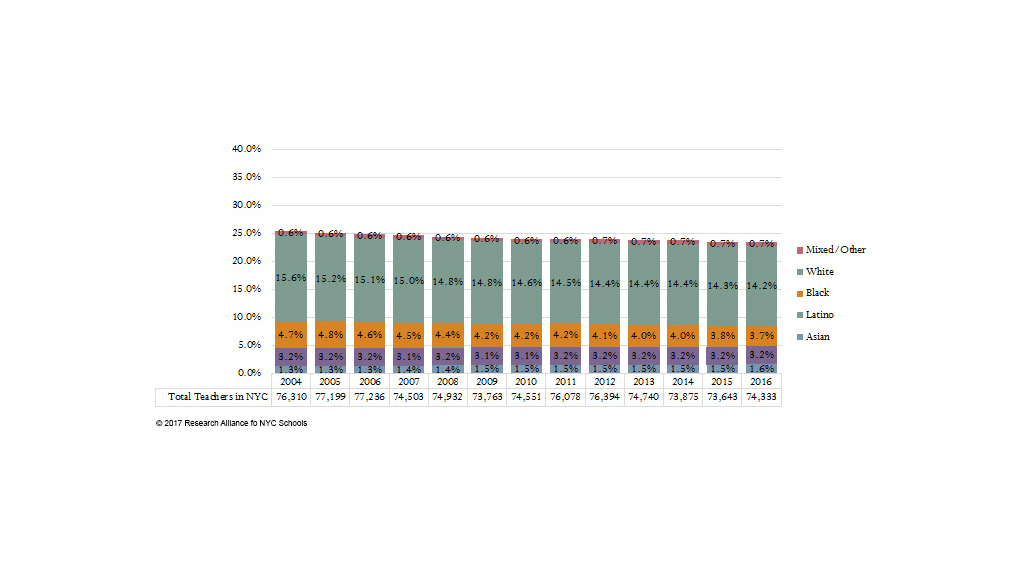In 2015, New York City launched “NYC Men Teach,” an initiative aiming to “put an additional 1,000 men of color on course to become NYC public school teachers over the next three years.” The initiative comes in response to a growing body of evidence suggesting that it is important for students of color to have access to educators of color.
Key Stats
Between the 2003-2004 and 2015-2016 school years:
- The proportion of male teachers in the City’s workforce actually fell a little. But the percentage of these male teachers who are not White remained steady at around 39%.
- Male teachers of color accounted for 9.8% of the City’s entire teacher workforce in 2003-2004, falling slightly to 9.2% in 2015-2016.
In a City that employs over 70,000 teachers, an extra 1,000 might seem like a drop in the bucket. But, as seen in a previous Spotlight post, men make up a relatively small proportion of the City’s teacher workforce (around 23% in 2015-2016), and men of color represent an even smaller share: Between 2003-2004 and 2015-2016, non-White males consistently accounted for about 9.5% of the City’s teachers.[1]
The graph below illustrates the race/ethnicity of the City’s male teachers, as a proportion of the overall teacher workforce, over the last 13 years.[2]
Figure 1: Ethnicity of Male Teachers in NYC, 2003-2004 through 2015-2016

In 2004-2005, 38.6% of NYC’s male teachers were not White—and this percentage has remained relatively unchanged. In 2015-2016, the most recent year for which we have data, there were about 6,800 male teachers of color in NYC, out of a total workforce of more than 74,000. In the face of these numbers, an additional 1,000 hires would represent meaningful change: a 14.6% increase in the number of male teachers of color in the system.
Looking at Black, Latino, and Asian men more closely, we see that:
- The number of Black male teachers in the system has actually fallen from almost 3,600 in 2003-2004 to around 2,750 in 2015-2016. Their share of the City’s entire teacher workforce dropped 1 percentage point, from 4.7% to 3.7%.
- The number of Latino male teachers has remained almost constant, hovering at around 2,400. They make up around 3% of the City’s total teacher workforce.
- The number of Asian male teachers has also remained steady, at around 1.5% of the total teacher workforce (just under 1,200 in 2015-2016).
For comparison, in 2015-2016, 13.2% of the City’s students were Black males, 19.7% Latino males, 7.4% Asian males, and 10.5% White males.[3]
Recent reports indicate that the NYC DOE increased the number of male teachers of color hired in the 2016-2017 school year. In future years, we will continue to track the demographics of NYC’s teachers, to help assess the effectiveness of NYC Men Teach and other efforts to hire a more diverse teacher workforce.
Big Questions:
NYC Men Teach provides a unique opportunity to learn about efforts to diversify teaching. For example:
- What strategies are effective for recruiting male teachers of color?
- Are certain school characteristics (for example, school safety; relationships among teachers; or leadership) associated with attracting or retaining male teachers of color?
- Nationally, male teachers of color are more likely to leave their school or the profession than other teachers. What are teacher turnover rates for male teachers of color in NYC? Are these rates different for teachers recruited through NYC Men Teach?
What else should we be asking about NYC’s teacher workforce? Are you exploring any of these topics? Let us know via email.
This post was developed using data provided to the Research Alliance for New York City Schools by the NYC Department of Education. Analyses conducted by Lisa Merrill and David Kang.
Footnotes
[1] See "What is the Gender Breakdown of NYC Teachers?" for the full size of the teacher workforce during this period.
[2] The graph includes all full-time and substitute teachers for NYC public schools in October of a given year (including general education and special education). This includes classroom teachers and other employees classified as teachers, e.g., reading coaches, technology specialists, etc. The graph and numbers in the text exclude teachers whose gender was missing from our data. The “other/mixed” category includes individuals identified as Native American (fewer than 100 male teachers each year), those who indicated their ethnicity is mixed, or those whose ethnicity is unknown.
[3] Research Alliance calculations.
How to Cite this Spotlight
Merrill, L., Kang, D. 2017. "How Many Male Teachers of Color Work in NYC?" Spotlight on NYC Schools. Research Alliance for New York City Schools.

